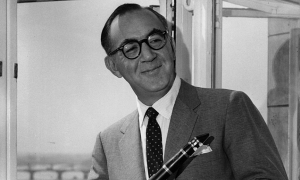Home » Jazz Articles » Late Night Thoughts on Jazz » Respect for Hank Mobley
Respect for Hank Mobley
Unbelievably, most of Mobley's excellent Blue Note work didn't come to light until the 1980s.
 Hank Mobley always suffered from the perception in some quarters that he was neither an innovative nor particularly gifted improviser. This is hogwash, as the many Mobley reissues that are becoming available demonstrate. The main problem most listeners had with Mobley was that he was not fortunate enough to be born John Coltrane or Sonny Rollins. With these two tenor players seen as the most interesting and gifted of the time, Mobley was relegated to the back burner of mere competency, which has damned many a jazz musician to obscurity.
Hank Mobley always suffered from the perception in some quarters that he was neither an innovative nor particularly gifted improviser. This is hogwash, as the many Mobley reissues that are becoming available demonstrate. The main problem most listeners had with Mobley was that he was not fortunate enough to be born John Coltrane or Sonny Rollins. With these two tenor players seen as the most interesting and gifted of the time, Mobley was relegated to the back burner of mere competency, which has damned many a jazz musician to obscurity. What is forgotten is that prior to joining Miles Davis' group Mobley was an original member of the Jazz Messengers with Horace Silver and Art Blakey. When Silver went out on his own, Mobley went with him, appearing on recordings such as The Stylings of Silver. At this time Mobley also recorded several Blue Note albums under his own name, including Soul Station and the newly reissued Roll Call . Roll Call is one swinging album, featuring a supporting cast that includes Freddie Hubbard and Art Blakey as well as pianist Wynton Kelly and bassist Paul Chambers, both of whom had recently participated in the recording sessions for Miles Davis' Kind of Blue.
Mobley's very first solo on the title track demonstrates his ability to convert rhythmic and melodic conceptions into a fluent, well-constructed solo in an almost intuitive manner. This gives his playing a relaxed feeling that is reminiscent of Lester Young, and probably accounts at least partially for the way he was largely ignored by the jazz public. Freddie Hubbard, already laboring under the assertion in some quarters that he was 'the new Miles,' rises to the occaision on Roll Call , offering incendiary solos on the title cut as well as on "My Groove Your Move" and "A Baptist Beat." Mobley the composer is also on display here, with all the tracks composed by him save for the standard "The More I See You." While the blues/soul melodies that characterized hard bop in general and the work of Horace Silver in particular is in evidence in Mobley's compositions, there is also a look back to the harmonic acrobatics of the original beboppers. While the public's appetite for something new made it impossible for Mobley to be seen as anything but a throwback by many, he was very much a musician of his time, and a superb one at that.
Following his time with Miles (documented on the excellent reissue Friday and Saturday Night at the Blackhawk Complete ) Mobley again settled in at Blue Note, recording the classic album No Room For Squares (an inspiration, at least in title, to John Mayer), among others. By 1969 Mobley was living in Europe, and his album The Flip was recorded in Paris by Francis Wolff. The musicians here are American expatriates (with the exception of bassist Alby Cullaz), a sad fact of life in the late 1960s and early 1970s, as Leonard Feather points out in his original liner notes. Trumpeter Dizzy Reece, a native of Jamaica, lived in Britain for many years before migrating to New York at the end of the 1950s. By the time the '60s came to an end he was back in Europe; despite several good Blue Note releases, he remained almost completely unknown in the U.S. Slide Hampton and Philly Joe Jones, two of America's finest jazz men at the time had settled more or less permanently in Europe at the time The Flip was recorded, and pianist Vince Benedetti had a successful career in Paris.
While The Flip may not be the absolute instant classic that Soul Station and Roll Call were, it is a fine outing that demonstrates the extent to which Mobley was maturing as a player. True, there is nothing far out or especially innovative here, but the recording is a demonstration of small group jazz at its finest, with every member contributing heartily towards the end result. Mobley's compositions, including "The Flip" and "Feelin' Folksy" pay tribute to the emergence of soul jazz and the Latin samba feel without trying too hard to sound trendy, which is one reason they still sound so good today.
Mobley's last recording for Blue Note, and his last as a leader, was Thinking of Home. Mobley and company were back in the Van Gelder Studios for this date from July of 1970. The opening track, "Suite" is divided into three sections—'Thinking of Home,' 'The Flight,' and "Home At Last.' It is Mobley's only experiment with an extended composition, and it shows that Mobley was not standing still, nor was he overly influenced by the flavor of the day. Opening with a minor rubato section, the piece quickly jumps into a full-force bebop section that features absolutely first rate solos from trumpeter Woody Shaw and Mobley himself. By the time the piece moves into a gentle bossa nova that features guitarist Eddie Diehl to great effect, the listener has been transported into a reverie that does indeed evoke thoughts of home. The album is rounded out by the Mobley ballad "Justine" and the hard bop workouts "You Gotta Hit It" and "Talk About Gittin' It," both of which feature Shaw, Mobley, and pianist Cedar Walton, as well bassist Mickey Bass' bluesy composition "Gayle's Groove."
Unbelievably, most of Mobley's excellent Blue Note work didn't come to light until the 1980s. Thinking of Home wasn't released until 1980, while Soul Station , an album that appears on more than one critic's list of Desert Island Discs, didn't see the light of day until 1987. In fact, it was the reemergence of Blue Note and their subsequent reissue program that did more to encourage a reassessment of Mobley's work than anything. In his liner notes to the 1980 release of Thinking of Home Todd Barkan wrote "Hank Mobley today is in need of 'a decent saxophone' so he won't 'blow one of his lungs out.'" Mobley died in 1986, still sadly neglected by jazz fans and writers. Check out these Blue Note reissues and rediscover a great talent.
Tags
PREVIOUS / NEXT
Support All About Jazz
 All About Jazz has been a pillar of jazz since 1995, championing it as an art form and, more importantly, supporting the musicians who make it. Our enduring commitment has made "AAJ" one of the most culturally important websites of its kind, read by hundreds of thousands of fans, musicians and industry figures every month.
All About Jazz has been a pillar of jazz since 1995, championing it as an art form and, more importantly, supporting the musicians who make it. Our enduring commitment has made "AAJ" one of the most culturally important websites of its kind, read by hundreds of thousands of fans, musicians and industry figures every month.





















